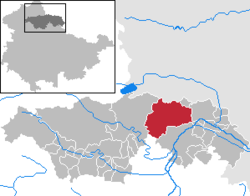Frankenhausen
| Bad Frankenhausen | ||
|---|---|---|

Frankenhausen Castle
|
||
|
||
|
Location of Bad Frankenhausen within Kyffhäuserkreis district
|
||
| Coordinates: 51°21′21″N 11°6′4″E / 51.35583°N 11.10111°ECoordinates: 51°21′21″N 11°6′4″E / 51.35583°N 11.10111°E | ||
| Country | Germany | |
| State | Thuringia | |
| District | Kyffhäuserkreis | |
| Government | ||
| • Mayor | Matthias Strejc (SPD) | |
| Area | ||
| • Total | 65.85 km2 (25.42 sq mi) | |
| Elevation | 132 m (433 ft) | |
| Population (2016-12-31) | ||
| • Total | 8,975 | |
| • Density | 140/km2 (350/sq mi) | |
| Time zone | CET/CEST (UTC+1/+2) | |
| Postal codes | 06567 | |
| Dialling codes | 034671 | |
| Vehicle registration | KYF | |
| Website | www.bad-frankenhausen.de | |
Bad Frankenhausen (officially: Bad Frankenhausen/Kyffhäuser) is a spa town in the German state of Thuringia. It is located at the southern slope of the Kyffhäuser mountain range, on an artificial arm of the Wipper river, a tributary of the Unstrut. Because of the nearby Kyffhäuser monument dedicated to Emperor Frederick Barbarossa, it is nicknamed Barbarossastadt. The municipality includes the villages of Seehausen, Udersleben and (since 2007) Esperstedt.
Frankenhausen was first attested as a Frankish settlement in the 9th century in deeds of the Abbey of Fulda. It received town privileges in 1282 and from 1340 on was part of the County of Schwarzburg.
On 15 May 1525 it was the location of the Battle of Frankenhausen, one of the last great battles of the German Peasants' War, when the insurgent peasants under Thomas Müntzer were defeated by troops of the allied Duke George of Saxony, Landgrave Philip I of Hesse and Duke Henry V of Brunswick-Lüneburg. Müntzer was captured, tortured and finally beheaded at Mühlhausen on 27 May.
With the partition of Schwarzburg County in 1599, Frankenhausen became the capital of the Unterherrschaft subdivision of the County of Schwarzburg-Rudolstadt, which in 1710 was raised to a principality. Prince Günther Victor was the last German monarch to abdicate, on 23 November (as Prince of Schwarzburg-Rudolstadt) and 25 November 1918 (as Prince of Schwarzburg-Sondershausen). The succeeding short-lived Free State of Schwarzburg-Rudolstadt merged into the newly created Thuringia in 1920.
...
Wikipedia



